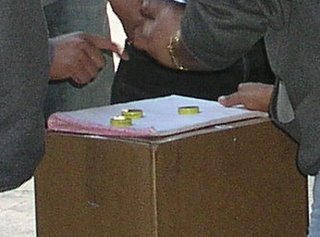Blogging the Wolfe Book, Neutral Milk Hotel

I was at a signing at Book Soup last night for Kim Cooper’s “In the Aeroplane Over the Sea” (important note: there’s parking behind the store, otherwise you have to contend with West Hollywood’s insane parking situation. Those people aren’t cruising Sunset Boulevard, they’re just looking for a parking place). The attendant at the lot two blocks away ($7) asked me if I was headed for the Roxy, which made me laugh all night. Yeah, that’s me, Mr. Viper Room.
A common question at the signing: C’mon, Harnisch, are you really going to blog the entire Wolfe book?
I don’t know. People tell me what a great book this is, so I’m obligated to read it. Especially since 1) I met Donald H. Wolfe at the district attorney’s office when he was researching the Dahlia case and even sent him some documents, and 2) he uses some of my material (sans permission or acknowledgement) without changing a comma.

Still, there are rewards to reading a book at the molecular level. For example, I’m continually entertained by “Black Dahlia Avenger’s” absurdly confident statement (Page 3) that the Los Angeles Police Department handled such important murder cases as the “Red Light Bandit” (Caryl Chessman, left, was executed even though he never killed anybody, which was one reason his case was so controversial), Bugsy Siegel (Beverly Hills Police Department) and Fatty Arbuckle (take that, San Francisco Police Department).
Here’s the two-minute executive summary on “Mogul”:
This book is bad. It is based on secondary sources (and doesn’t even handle them well), misspells names, mangles the facts, exaggerates details and suppresses crucial information. All this in the first eight pages of background. Believe me, if a book can’t be trusted with simple information, it isn’t going to suddenly get better when the material gets more complicated.
OK, executives, you can stop reading now. Anyone else, as they say in the Marines: “Follow Me.”
Page 8
The legs were disconnected from the waist… The breasts seemed to have been detached…
I don’t like talking about the condition of the body but this makes it sound as if the legs were separated at the pelvis. Elizabeth Short was cut just above the waist. And the claim about the breasts is wrong, according to the transcript of the autopsy included in the inquest.
Mrs. Bersinger noticed that the head had been badly damaged and that there were red marks on the face. She suddenly stopped pushing the baby stroller and stared at the broken head in frozen disbelief as she realized that the red marks were congealed blood…
This is a nice bit of literary three-card monte (shout out to Nathan Marsak, thanks for the picture, crime buddy). Wolfe needs to introduce th
 e condition of the body so he hangs it on Bersinger, except it didn’t occur that way.
e condition of the body so he hangs it on Bersinger, except it didn’t occur that way.Let’s take “the breasts seemed to have been detached.” To whom did it seem that way? Bersinger? For the record, she doesn’t give interviews. I was lucky enough to talk to her and her husband, John, in 1996, and they are wonderful, gracious people. But she does not like discussing the Black Dahlia murder doesn’t talk to the media any more.
In her interview with me, however, she described her encounter as being very brief. She did not stand and gape at the body, but saw it out of the corner of her eye as she was focusing on the stroller, looked just long enough to realize what was in the grass and hurried down the street to report it.
Since she didn’t talk to Wolfe, he used the original Examiner story and “Childhood Shadows.”
And what do we find in “Childhood Shadows” Page 68?
Uh-oh.
“The head was turned slightly toward her, but Mrs. Bersinger couldn’t see the features. Everything was blurry.”
But what about: “Mrs. Bersinger noticed that the head had been badly damaged and that there red marks on the face”? What about she “stared at the broken head in frozen disbelief”?
Nope. Nobody has ever said that. Not Wolfe’s two supposed sources and especially not Bersinger in her interview with me. Historians don’t get the protection of artistic license—this is called lying.
I mean, don't you think if you cite something in your bibliography you should use it rather than completely contradict it? Otherwise it's window dressing. I'm sure they taught students how to write a research paper, with proper footnotes and bibliography, at Beverly Hills High. ("Mogul," Page 6). That's the least we demand from students doing elementary research papers in remedial English. Why should we expect less from a $30 book? This means you, ReganBooks.
And for the record, the killer washed and scrubbed the body, so there wasn’t any congealed blood.
I have to go for a walk.
Labels: Black Dahlia, Books and authors, Hollywood, Homicide, LAPD, Streetcars




0 Comments:
Post a Comment
<< Home